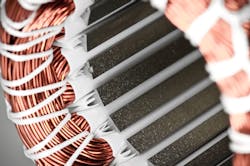Protecting Motors from Voltage Unbalance
Voltage unbalance can be a common steady-state power quality problem that is harmful to 3-phase electric motors. The condition can cause overheating and insulation damage. The cost of damage to motors can be significant and, in most cases, completely avoidable.
Protecting motors from voltage unbalance is relatively simple and low cost if considered during design and engineering. To protect your investments, it is prudent to plan for 2% to 3% voltage unbalance.
Circuit breakers, fuses, and motor overloads are all required by the National Electrical Code (NEC) to provide overcurrent protection. However, these devices will not operate fast enough to shut a motor down when a voltage unbalance occurs. Consideration of additional motor protection and motor size de-rating will provide better protection.
Motor protection is designed to be added to the normal start-stop control system as a relay. The relay is designed to monitor the current and voltage of all three phases. The relay uses the inputted values to calculate the voltage unbalance, current unbalance, high voltage, low voltage, undercurrent and overcurrent. When preset thresholds are met, the onboard normally open and normally closed contacts operate.
Typically, you interrupt the control power to the motor starter coil to stop the motor. These relays operate much faster than standard motor overload protection can. Often, the factory settings are not correct and need to be adjusted. For example, one manufacturer sends its relays out with 6% voltage and 6% current unbalance. Unfortunately, with these settings, the motor will trip on current unbalance first with only a 0.5% to 1% voltage unbalance. The actual settings must be specified by the electrical engineer or the electrical contractor designing the system.
De-rating the motor is another option to consider when designing the installation. NEMA MG-1-2016 (Motors & Generators) provides multiple sections that detail various motor types: small and medium AC and DC motors: 3-phase synchronous motors; and 3-phase squirrel-cage motors. All three provide the same de-rating recommendations (Table, below). By de-rating the motor you are actually increasing the horsepower size.
For example, to plan for a 3% voltage unbalance with a 100-hp 3-phase motor, the de-rating factor of 88% is used. This calculates to only allowing the motor to do the work of 88 hp. The motor size needs to be increased 12 hp to 15 hp to accommodate the 3% voltage unbalance. For most motors, this equates to the average service factor. Unfortunately, however, many installers try to save money by installing the motor to operate at the service factor. Running at the service factor eliminates the motors' ability to handle more than 1% to 2% voltage unbalance.
It is always advised to allow the service factor to provide the buffer needed during operations to deliver better reliability for the customer. Proper planning and design of motor installations, when considering voltage unbalance, will protect motors and provide superior operations for the system.
About the Author
Bryan Glenn
Power Quality Consultant
Bryan Glenn is a power quality consultant for EC&M magazine. He can be reached at [email protected].

